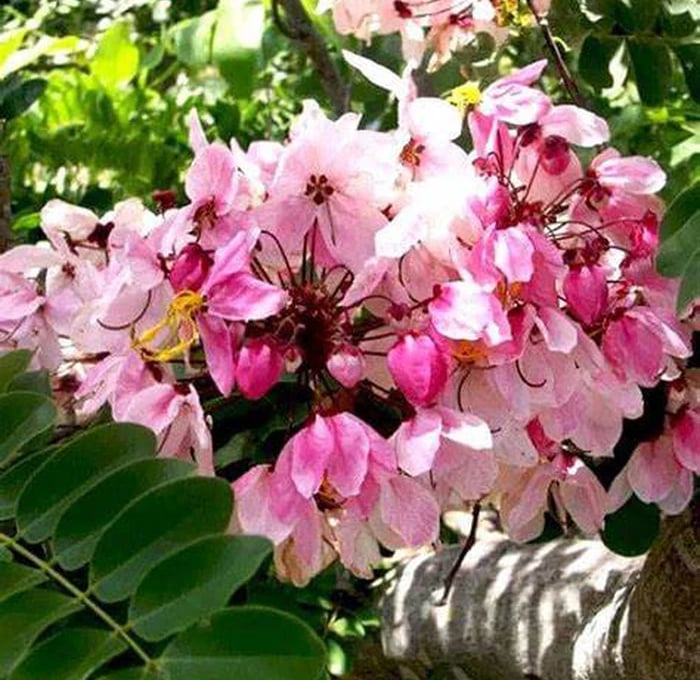Pink Shower Tree: Cassia javanica
Alicia
5/22/2025


If you’ve been wandering around town recently, you might have noticed a spectacular splash of colour lighting up the streets and gardens—the enchanting Cassia javanica, commonly known as the Pink Shower Tree. This incredible tree is not just a treat for the eyes but also a resilient performer perfectly suited to the challenging conditions of semi-arid Winton, especially in our heavy clay soils.
Cassias are a diverse genus of flowering trees and shrubs, beloved across tropical and subtropical regions for their abundant, vibrant blooms and graceful forms. Many cassias showcase bright yellow flowers, but the Pink Shower Tree stands out with its soft yet striking pink blossoms that cascade like a delicate shower in springtime.
Colour and Charm
The Cassia javanica bursts into flower with clusters of large, five-petalled blooms in shades ranging from pale blush pink to a deeper rose, often with subtle hints of white and yellow at the centre. These flowers attract a variety of native pollinators, including bees and butterflies, adding life and movement to your garden while filling the air with a light, sweet fragrance.
Unlike many ornamental trees with smooth or pale bark, the Pink Shower Tree’s trunk is textured and rugged, with a sturdy, woody appearance that tells the story of resilience. Its bark often reveals a patchwork of greys and browns, thick enough to withstand the harsh sun and winds of Winton’s climate.
This medium to large deciduous tree typically grows between 6 to 12 metres tall, forming a broad, spreading canopy. The trunk supports wide-reaching branches that offer excellent shade, making it a natural choice for cooling outdoor spaces in our hot semi-arid environment.
One of the remarkable features of the Pink Shower Tree is its adaptability. Despite its tropical origins, it flourishes here because:
Drought Tolerance: Once established, it copes well with low water availability, a vital trait for semi-arid regions.
Heavy Clay Soil Compatibility: Unlike many trees that struggle in dense, heavy clay soils that dominate Winton, the Pink Shower’s root system penetrates and adapts, benefiting from the moisture retention clay provides while avoiding waterlogging.
Heat and Sun Resistance: Its thick bark and deciduous habit allow it to conserve resources during the hottest months and regrow fresh foliage and flowers as conditions improve.
Benefits of Planting
Shade and Shelter: Its wide canopy provides generous shade, perfect for gardens, parks, or streetscapes seeking relief from the harsh sun.
Wildlife Habitat: The flowers support pollinators, while the tree itself offers habitat and shelter for birds and insects.
Aesthetic Appeal: The show-stopping pink blossoms make this tree a local favourite for beautification projects, gardens, and community spaces.
Low Maintenance: Once established, it requires minimal watering and care.
Best Places to Plant
For optimal growth and long-term enjoyment, consider these placement tips:
Space to Grow: Allow room for its spreading canopy—plant at least 6 to 8 metres away from buildings or structures.
Full Sun: Plant where it receives ample sunlight to encourage vibrant flowering.
Well-Drained Soil: While tolerant of clay, ensure the planting spot has good drainage to prevent root rot.
Shade Needs: Ideal near patios, playgrounds, or sitting areas where shade is appreciated.
The Cassia javanica Pink Shower Tree is a striking and practical addition to any Winton landscape. Its beautiful pink blooms, resilience to drought and clay soils, and generous shade make it a perfect match for our semi-arid environment.
Subscribe to our newsletter
We gratefully acknowledge the Koa people as the traditional custodians of the land on which Ironstone Garden Centre operates. For generations, the Koa people have cared for and nurtured this land, enriching it with their knowledge, culture, and deep connection to Country. We honour their ongoing stewardship and the enduring legacy they have created. As guests on Koa Country, we humbly pay our respects and commit to listening, learning, and working with the Koa community.
